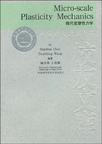微尺度塑性力学
2009-5
中国科学技术大学出版社
陈少华,王自强 编著
280
无
大学最重要的功能是向社会输送人才。大学对于一个国家、民族乃至世界的重要性和贡献度,很大程度上是通过毕业生在社会各领域所取得的成就来体现的。中国科学技术大学建校只有短短的50年,之所以迅速成为享有较高国际声誉的著名大学之一,主要就是因为她培养出了一大批德才兼备的优秀毕业生。他们志向高远、基础扎实、综合素质高、创新能力强,在国内外科技、经济、教育等领域做出了杰出的贡献,为中国科大赢得了“科技英才的摇篮”的美誉。2008年9月,胡锦涛总书记为中国科大建校五十周年发来贺信,信中称赞说:半个世纪以来,中国科学技术大学依托中国科学院,按照全院办校、所系结合的方针,弘扬红专并进、理实交融的校风,努力推进教学和科研工作的改革创新,为党和国家培养了一大批科技人才,取得了一系列具有世界先进水平的原创性科技成果,为推动我国科教事业发展和社会主义现代化建设做出了重要贡献。据统计,中国科大迄今已毕业的5万人中,已有42人当选中国科学院和中国工程院院士,是同期(自1963年以来)毕业生中当选院士数最多的高校之一。其中,本科毕业生中平均每1000人就产生工名院士和700多名硕士、博士,比例位居全国高校之首。还有众多的中青年才俊成为我国科技、企业、教育等领域的领军人物和骨干。在历年评选的“中国青年五四奖章”获得者中,作为科技界、科技创新型企业界青年才俊代表,科大毕业生已连续多年榜上有名,获奖总人数位居全国高校前列。
本书系统地介绍了材料微尺度力学行为的尺寸效应实验现象,重点介绍了几种具有代表性的微尺度应变梯度塑性理论及对微尺度实验现象的解释,以及对裂纹尖端微尺度范围内解理断裂的应用。此外,还融会贯通地介绍了国内外学者的原创性工作和创新性学术思想。 全书共8章。第1章介绍了应变梯度塑性理论的应用背景及经典微极理论;第2章介绍了金属材料典型的微尺度力学实验现象;第3至7章介绍了几种典型的应变梯度理论及其应用;第8章介绍了应变梯度理论在微观断裂力学中的应用。 本书适合从事固体微尺度力学、先进材料的微结构设计与力学性能优化、微机电和微电子元件力学行为研究的科技工作者及工程师使用和参考,也可供力学专业及材料专业的高年级本科生和研究生阅读参考。
Preface to the USTC Alumni's SeriesPreface1 Introduction 1.1 Brief introduction of experimental observations 1.2 An overview of strain gradient plasticity theory 1.3 Micro-polar theory2 Micro-scale experiments 2.1 Torsion experiments on copper wires 2.2 Micro-meter thin-beam bending 2.3 Micro-meter particle reinforced metal matrix composite 2.4 Micro and nano-indentation3 Theories proposed by Fleck and Hutchinson 3.1 Couple stress theory (CS) 3.2 Strain gradient (SG) theory proposed by Fleck and Hutchinson (1997) 3.3 Torsion of thin wires 3.4 Bending of thin beams 3.5 Micro-indentation hardness 3.6 Size effects in particle reinforced metal matrix composites4 MSG and TNT theories 4.1 A law for strain gradient plasticity 4.2 Deformation theory of MSG 4.3 Bending of thin beams 4.4 Torsion of thin wires 4.5 Micro-indentation hardness 4.6 Size effects in the particle-reinforced metal matrix composit 4.7 Taylor-based non-local theory of plasticity (TNT)5 C-W strain gradient plasticity theory 5.1 A hardening law for strain gradient plasticity theory 5.2 C-W couple-stress strain gradient plasticity theory 5.3 Verification of C-W couple-stress strain gradient plasticity theory 5.4 C-W strain gradient plasticity theory 5.5 Thin wire torsion and ultra-thin beam bend 5.6 Micro-indentation hardness 5.7 Size effects in particle reinforced metal-matrix composites6 Strain curl theory 6.1 The continuum theory of dislocation 6.2 Plastic strain curl theory 6.3 Finite element simulation of micro-indentation tests7 Strain gradient theory based on energy non-local model 7.1 Classical non-local theory of elasticity 7.2 A new framework of non-local theory 7.3 Constitutive equations of strain gradient theory 7.4 Thin wire torsion and ultra-thin beam bend 7.5 Analysis of micro-indentation8 Cleavage fracture near crack tip 8.1 Steady-state crack growth and work of fracture for solids characterized by strain gradient plasticity 8.2 Fracture in MSG plasticity 8.3 Application of C-W strain gradient plasticity on the cleavage fracture of crack tip 8.4 Prediction of strain-curl theory on plane-strain crack tip field
插图:(1994), the tension tests were performedon a 50 mm gauge length of copper wire, using a conventional screwdriven test machine and a specially designed sensitive load cell. The loadcell consisted of a 0.5 mm thick cantilever beam of rectangular section~ itwas loaded transversely at its free end by the copper wire. Strain gaugeswere placed near the built-in end of the beam and were used to detect theload on the copper wire.The torsion tests were performed using a specially designed screwdriven torsion machine sketched in Figure 2.1. The bottom end of thecopper wire specimen (of gauge length2 mm) was glued to a lower grip, and thetop end to a 60 mm long glass filament~ theglass filament acted as a torsional load cell.The free end of the glass filament wastwisted using a gear drive train and electricmotor. The twist along the length of theglass filament was measured by two needlepointers and protractors, and gave ameasure of the torque. Calibration of theglass filament load cell was carried outseparately using a dead weight and pulleyarrangement. The torsional strength of the copper wires roughly scaleswith diameter to the third power, to maximize sensitivity of the torsionalload cell glass filaments were used of diameter in the range 55 -250micrometers. The relative twist of the two ends of the copper wire was measuredby the needle pointer attached to the top end of the wire (the other endwas fixed to the lower grip of the test machine which could translate butnot rotate). During a test the wire was elongated by a few percent,causing the glass filament to bow. This was corrected for by translatingthe lower grip of the test machine via a gear drive.
《微尺度塑性力学》是陈少华等编著的,由中国科学技术大学出版社出版。

无
院士著作,值得一读
这本书是英语写的,读过其它类似的书的读者适合用此本书,第一次接触的不建议用此书
有力学所陈少华研究员和王自强院士编著的该书是国内第一本系统介绍应变梯度塑性理论等非局部理论的著作,内容前沿,翔实,系统,该书介绍了几种典型的梯度理论,尽管应变梯度理论还在发展中,该书无疑将成为微尺度塑性力学中的一部经典之作。不过内容是英文的,要有一定的专业基础才能读懂。推荐!!